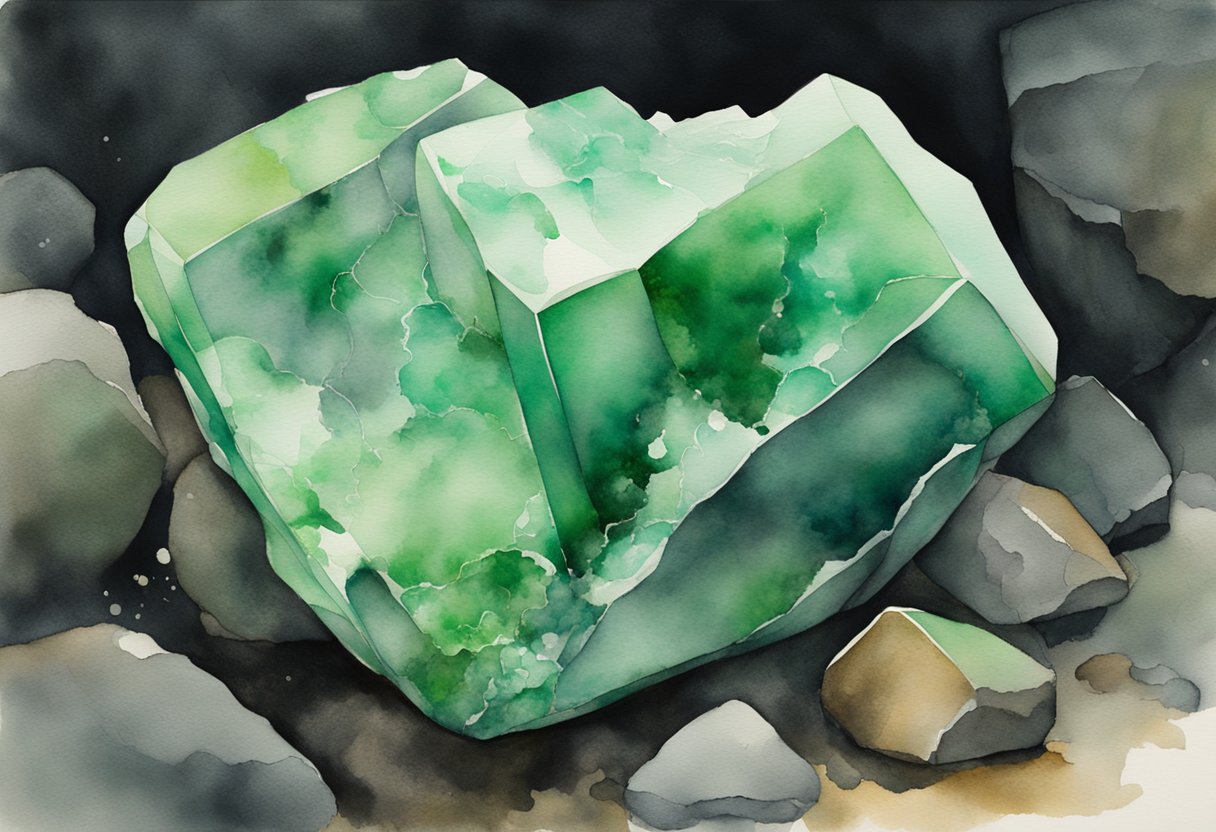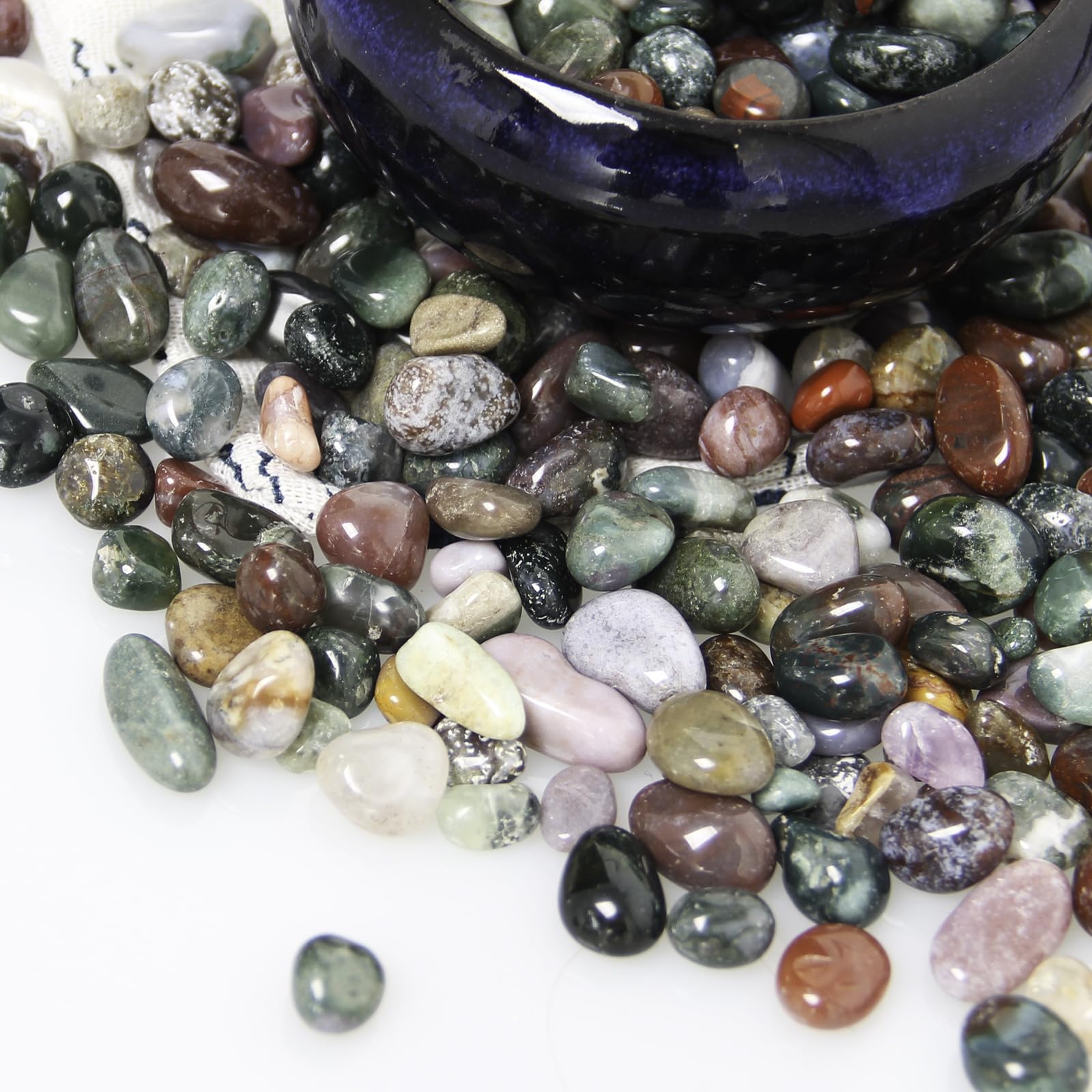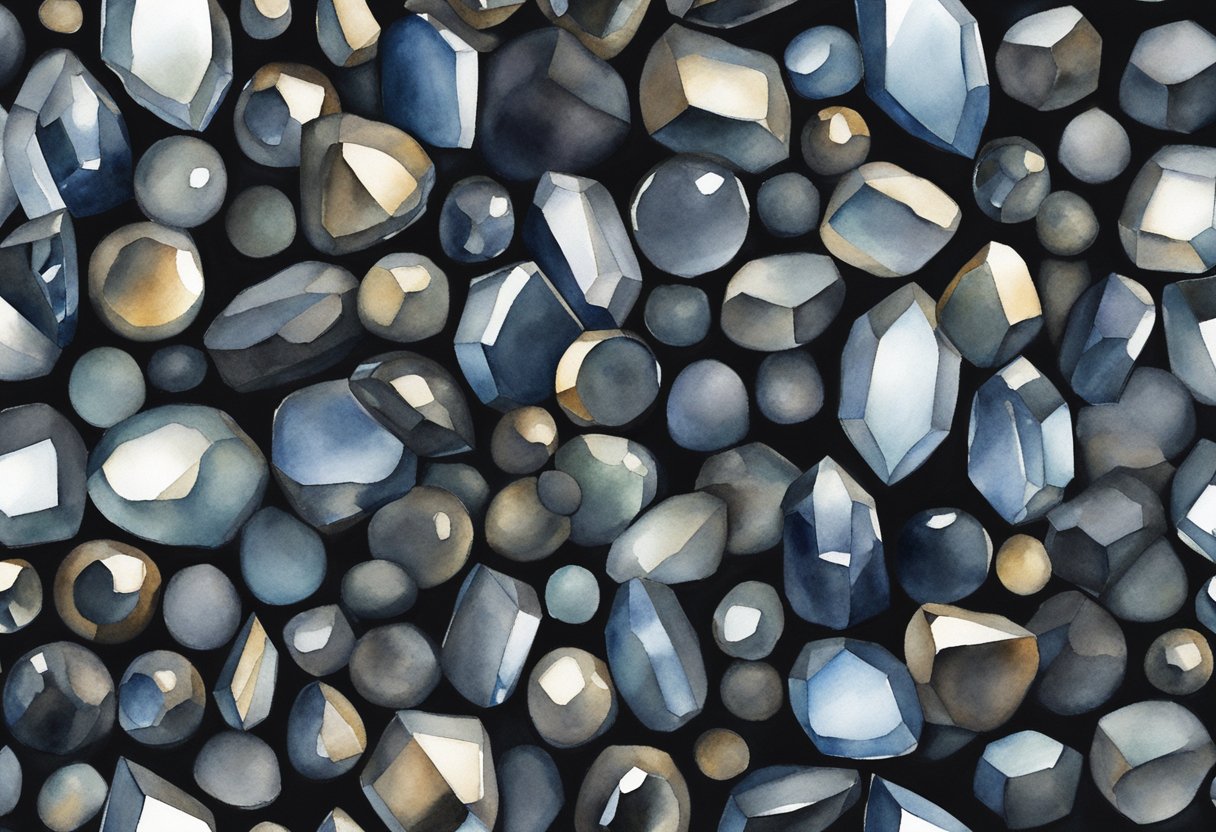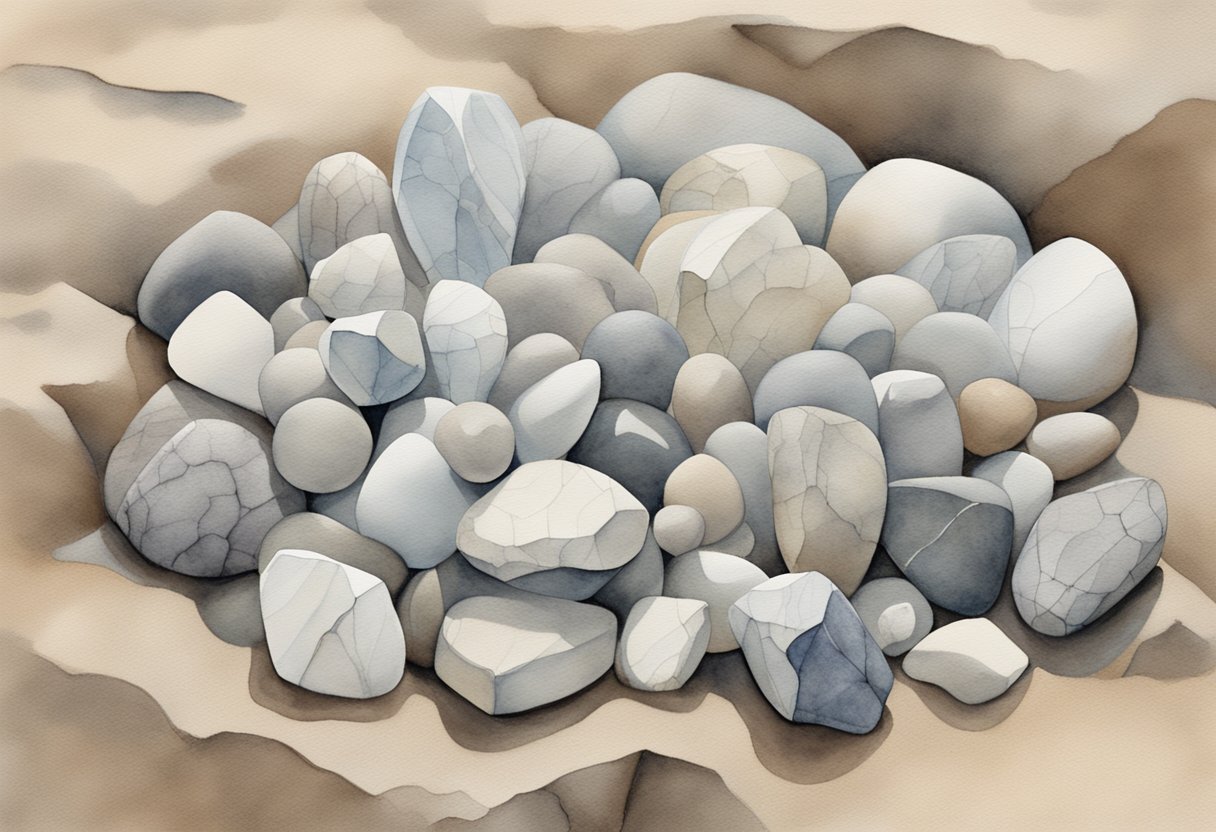
Magical Properties of Jadeite
Howlite, a serene gemstone with a milky white hue and delicate gray veining, has been cherished for its calming and healing properties. Known as a stone of tranquility, Howlite promotes emotional balance, reduces stress, and...
Jadeite, a gemstone rich in both beauty and history, has long fascinated human cultures with its alluring hues and purported mystical properties. Revered across centuries, jadeite’s distinctive colors range from the deepest greens to delicate whites intermingled with green spots. This mineral, often associated with luxury and prestige in various societies, is more than just an ornamental stone; it’s embedded with a legacy of deep cultural significance, especially within Chinese tradition.
The charm of jadeite extends beyond its visual appeal, as it is believed to house metaphysical qualities that transcend its physical form. Cultures around the world have attributed healing and protective properties to jadeite, considering it a stone that can influence wellbeing and fortune. The captivating emerald hues are not the sole reason for its esteemed status; the stories and beliefs it carries add a layer of enchantment to this already impressive mineral.
Key Takeaways
- Jadeite’s allure is rooted in its visual splendor and historical reverence.
- Attributed metaphysical properties extend its significance beyond ornamental uses.
- Its diverse range, from vibrant greens to mottled whites, enhance its desirability in various applications.
Historical Significance
When one peers into the annals of history, jadeite emerges not merely as a gemstone but as a catalyst of culture and sophistication. Its historical voyage weaves through myriad civilizations, each bestowing upon it a sacred status.
Origin and Etymology
The term “jadeite” derives from the Spanish “piedra de ijada,” reflecting the belief in its ability to treat ailments of the loins and kidneys. Myanmar stands as the primary source of imperial jade, deemed the most valuable, while significant deposits also grace lands like Guatemala and Japan. China’s affinity with jadeite dates back millennia, embedding the stone into the very soul of their identity.
Jadeite in Ancient Cultures
In profound respect, the Aztecs and Maya of Mexico and Central America exalted jadeite higher than gold. China crowned jadeite as the “Imperial Gem,” with its presence in regal artifacts symbolizing nobility and purity. Rituals and royal rites were often graced by this esteemed mineral, captivating the gaze of both peasant and emperor alike. Throughout Asia and Central America, jadeite served as a bridge between the earthly and the divine, carrying with it the whispers of ancient wisdom and the breath of the Earth.
Geological Formation and Types

Jadeite’s journey from the cradle of Earth to being revered in cultures is as compelling as it is complex. This mineral’s creation story is told through the profound forces of geology and chemistry.
Mineral Composition
Jadeite is a gemstone with a tale spun deep within the Earth’s mantle, where high pressure and low temperature conditions birth this captivating mineral. With a chemical score of NaAlSi2O6, it’s the child of the elements sodium, aluminum, and silicate. Unlike its cousin nephrite, jadeite boasts a pyroxene mineral structure—rocking the mineralogical world with its tightly woven grain patterns, which lend it exemplary hardness.
Color Variations and Sources
In terms of color, jadeite presents a veritable kaleidoscope ranging from the most iconic emerald green to hues of blue, white, and even black. It’s the presence of trace elements, like iron, that paints jadeite with a diverse palette, offering shades of yellow, pink, purple, orange, and red. Sources whisper tales of jadeite’s global journey, with key deposits in Myanmar supplying the world with vibrant greens; while in Guatemala, whispers of blue and lavender float through the market. This mineral’s allure is undeniable whether it is translucent, allowing light to dance through its form, or opaque, holding secrets in its solid colors.
Metaphysical Attributes

Renowned for its broad spectrum of metaphysical attributes, Jadeite is not only admired for its physical beauty but also for its connection with numerous energetic and healing properties. From fostering balance and harmony to attracting wealth and prosperity, Jadeite is regarded as a stone of heart-centric power and spiritual growth.
Energetic Influence and Feng Shui
Chi Impact and Placement:
- Harmonizer: Jadeite is believed to balance energies (yin and yang) and usher in peace.
- Abundance and Prosperity: Positioning Jadeite in specific areas is thought to enhance wealth.
- Protective Properties: It acts as a protective shield against negative forces.
Feng Shui Associations:
- Elemental Connection: The Earth element associated with Jadeite promotes stability and grounding.
- Directional Affinity: According to Feng Shui, placing Jadeite in the southeast area of a space augments abundance.
Healing and Emotional Properties
Heart Chakra Alignment:
- Love and Emotional Healing: Jadeite resonates with the heart chakra, fostering love and emotional recuperation.
- Calm and Peace: The stone’s soothing energies are said to calm the mind and invite peace.
Healing and Well-being:
- Physical Healing: Often linked with fertility and cleansing, contributing to a sense of physical well-being.
- Emotional Support: Jadeite offers a comforting embrace, purportedly mending the emotional fabric of the heart.
Benefits of Balance and Harmony:
- Positive Emotional States: By promoting balance, Jadeite encourages positive feelings and emotional stability.
- Wisdom and Insight: The wisdom-enhancing properties of Jadeite are thought to provide clarity and insight, aiding individuals in making prudent decisions.
Jadeite in Jewelry and Ornamentation

Jadeite’s luxurious sheen and rich array of colors, from the deep greens of imperial jade to the soft lavender and striking red shades, have captivated artisans and wearers alike. Used both as an an adornment and a symbolic figure, jadeite adorns jewelry and artifacts with its natural beauty.
Popular Jewelry Types
Jadeite is a cherished gemstone frequently set into various types of jewelry. Items such as rings, bracelets, and necklaces often feature jadeite as the centerpiece. Prestigious imperial jade, a highly translucent emerald-green jadeite, is particularly sought after for high-end pieces. In contrast, jadeite with hues of red or lavender brings a touch of unique color to the wearer’s ensemble.
- Rings and Earrings: Often showcase smaller jadeite gemstones, providing a subtle elegance.
- Bracelets and Bangles: Typically use larger pieces of jadeite, making a bold statement.
- Necklaces: Range from simple pendants to intricate necklaces interwoven with jadeite beads.
Carved Artifacts and Amulets
Artisans skillfully sculpt jadeite into a galaxy of intricate designs, transcending simple ornamentation and blossoming into powerful symbols and amulets. Traditional Chinese bi and pi discs, carved from jadeite, hold historical significance and are sometimes worn as an amulet for protection and good fortune. Carvers often infuse jadeite artifacts with the essence of nature, mimicking leaves or animals, weaving a visual narrative that echoes across the ages. These pieces are not only stunning visually but are also believed to carry metaphysical properties and are often kept close as protective talismans.
Cultural and Symbolic Meanings

Jadeite’s resonance with cultural ethos and mystical realms traverses geographical boundaries, enriching traditions with its spectrum of hues—varying from vibrant greens to tranquil whites, regal purples, and serene blues. This stone has embroidered itself into the tapestry of cultural identity and spiritual practice with its purported properties of harmonizing chi, fostering prosperity, and symbolizing purity.
Significance in Eastern Traditions
In the East, particularly within Chinese culture, jadeite is not merely a stone but an emblem of virtue and spiritual endowment. Deeply woven into the fabric of society, green jade signifies a connection to the Earth’s nurturing energies, believed to impart balance and serenity to the spirit. This crystalline mineral, often more prized than gold, encompasses the fullness of chi, the life force that pervades the universe. It is synonymous with success, courage, and prosperity, and is often associated with immortality due to its tenacious nature and enduring beauty.
Fertility and purity are also characteristics attributed to this treasured stone, encapsulating the essence of life’s beginnings and the unblemished state of being. Jadeite artifacts, ranging from delicate jewelry pieces to robust ceremonial axes, embody the carved history of aspirations for power and longevity.
Influence in Western Perspectives
From a Western vantage point, jadeite’s allure is more recent but no less pervasive. It’s infused with a lore that imparts feelings of love, joy, and confidence to those who keep it close. Here, jadeite is more than a gemstone; it’s seen as a conduit for meaning—a vessel through which one’s higher self is nourished. The rarity of jadeite in Western lands has long been a source of intrigue, inviting collectors and enthusiasts to seek out its varied hues, with white jade representing peace and tranquility, while blue jade is thought to unlock deeper intuition.
Those who look to the metaphysical have found purple jade to be a beacon of spiritual wisdom, a guide for the mind in its quest for expansion and understanding. The reverence for this stone transcends its physical allure, hinting at a shared human quest across cultures for tokens of unspoken truths and the power of nature’s gifts.
Modern Applications and Uses

Jadeite, a gemstone with a rich tapestry of history and cultural significance, continues to be cherished in contemporary times. Its versatility allows it to be incorporated into various aspects of modern life, from holistic healing to elegant home decor.
Therapeutic Benefits and Meditation
The use of jadeite in therapeutic practices is a testament to its enduring legacy as a source of healing properties. Individuals often turn to jadeite as a tool for meditation, where it is believed to promote harmony and balance. Its connection to health is not merely superficial; enthusiasts attribute jadeite’s abilities to foster positive energy and enhance well-being.
- Health: Aids in relaxation and stress relief.
- Wealth: Traditionally linked to prosperity, encouraging smart business decisions.
- Love: Thought to nurture emotional healing and foster healthy relationships.
- Dreams: Believed to inspire insightful dreams and reflective sleep.
Jadeite in Feng Shui and Interior Design
Jadeite, when woven into the fabric of Feng Shui, enriches the home with positive energies. Its harmonious essence is said to align with Feng Shui principles, promoting prosperity and wealth, while mitigating negativity.
- Feng Shui: Enhance the chi or energy flow in a space to boost health and abundance.
- Interior Design: Integrating jadeite in home accents or furniture pieces not only adds elegance but cultivates a serene atmosphere.
Adherents of jadeite’s influence align pieces at pivotal points throughout a space to magnify the stone’s sought-after attributes—whether it be for bolstering personal health, safeguarding the harmony of a home, or ensuring the smooth operation of a business.
Care and Maintenance of Jadeite

Jadeite’s lustrous appeal is the centerpiece of its beauty, demanding careful maintenance to preserve its radiance. Owners of this gemstone should take heed of several straightforward practices to ensure their jadeite remains resplendent.
Regular Cleaning: Jadeite thrives under a regimen of gentle care. It can be cleansed using a soft cloth and mild soap with lukewarm water. It is paramount to avoid hot water or steam cleaners, which can damage the stone. After cleaning, one should pat the stone dry with a different soft cloth to maintain its vitreous luster.
Cleaning Schedule:
- Daily: Wipe with a soft cloth to remove surface oils
- Weekly: Soak in lukewarm soapy water, then rinse and dry
- Monthly: Inspect for any surface scratches or changes in luster
Avoiding Harsh Chemicals: Jadeite should never mingle with harsh chemicals, as they can mar the surface and erode the stone’s polished façade. Even everyday substances like perfumes and lotions can be detrimental over time. It’s best to apply these products before donning jadeite jewelry.
Proper Storage: When not adorning its wearer, jadeite requires a safe haven—preferably a fabric-lined jewelry box or a pouch that prevents contact with other pieces. This prevention of scratches ensures that jadeite’s smooth complexion remains unblemished.
Physical Care: Despite its robustness on the Mohs hardness scale, jadeite can still suffer from rough treatment. One should avoid striking the stone against hard surfaces and shield it from potential impacts.
By following these guidelines, your jadeite will continue to enchant and captivate, its mystical charm undiminished by the passage of time.
Identifying Authentic Jadeite

To ensure the Jadeite in question is genuine, prospective buyers and collectors should be familiar with both hands-on tests and the common imitations prevalent in the market.
Tests and Expert Tips
One can conduct several at-home examinations to assess the authenticity and quality of Jadeite. Firstly, the scratch test helps determine the hardness of the gemstone; genuine Jadeite has a Mohs hardness of 6.5 to 7, which means it should be able to withstand scratching from substances of equal or lesser hardness. However, this test has its drawbacks and could potentially damage the stone. A density test can also offer clues, as Jadeite has a high density and should feel heavier than it looks.
When examining the stone, pay attention to its color and structure. Authentic Jadeite exhibits a smooth, even color with a vitreous luster. Using a strong light source to look for impurities and internal structures can also be revealing. Jadeite should have a fine, interlocking granular pattern, unlike the crystalline structure of other stones. For a foolproof verification, though, it is advisable to seek an assessment from a certified gemologist or to obtain a lab certification verifying the stone.
Common Imitations and Counterfeits
Jadeite’s allure has led to the development of numerous counterfeits that can fool the untrained eye. Nephrite, another form of jade, is often mistaken for Jadeite but is less valuable and has a different, softer mineral composition. Glass replicas, featuring dyed green glass, can mimic Jadeite’s appearance but lack the stone’s specific gravity and hardness.
Imitations like serpentine or dyed calcite can visually imitate Jadeite but generally lack its weight and solidity. These counterfeits typically have an excessively waxy luster or an erratic color distribution. One especially deceptive practice involves the layering of real Jadeite over a core of non-valuable material, a tactic known as “doublets.” For these reasons, it is crucial for buyers to exercise diligence by requesting documentation of authenticity and, when in doubt, consulting a professional is highly recommended.




 https://witchyhour.com
https://witchyhour.com